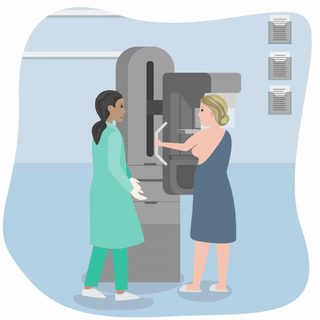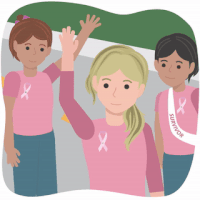
The numbers tell the story of breast cancer's impact on public health in the U.S. More than 4 million women have had a history of breast cancer, including women undergoing treatment and those who have finished treatment. And breast cancer accounts for about 30% of newly diagnosed cancers in women.1
Highly prevalent in the U.S., breast cancer affects the lives of millions of women — and men — each year. The financial costs of breast cancer can negatively affect people's lives, livelihoods and mental health. However, timely detection and awareness about breast cancer can provide an opportunity to catch it early — when it is most treatable and thus more affordable.
In addition to understanding potential treatments for breast cancer, patients should be aware of resources for paying for their care. In fact, everyone benefits from increased awareness of breast cancer's causes, treatments and payment options so they can better support those affected by this disease.
Types of Breast Cancer Screening

Early detection represents the key to finding breast cancer in its earliest stages, when it's the most treatable (and least expensive to treat). These screening methods can help detect breast cancer early:
-
Breast ultrasound. Ultrasound machines use sound waves that produce a sonogram, or image, of the tissue inside the breast.
-
Diagnostic mammogram. This test uses an X-ray-style machine to create highly detailed images of breast tissue by squeezing the breasts between two plates. Radiologists can find lumps, cysts or other abnormal tissue by reviewing these detailed X-rays.
-
Breast magnetic resonance imaging (MRI). This body scan uses magnetic technology connected to a computer to make even more detailed images of the tissue inside the breast.
-
Biopsy. If a lump or fluid occurs in the breast tissue, a physician may take a sample of this tissue — either in an outpatient scenario with a small needle or under anesthesia in surgery.
Breast cancer is often diagnosed in stages, which is a complex calculation that involves the following factors:
-
Whether or not the cancer is confined to the breast or has spread to other parts of the body
-
The size of the tumor
-
The number and locations of any lymph nodes involved
-
The use of a tumor grading system
Taking all of these factors into consideration, the physician will assign a number-and-letter stage (such as "IIA") to the breast cancer. At more advanced stages, breast cancer is more difficult and expensive to treat.
Should You Do Routine Breast Self-Examinations?

Physicians used to recommend that all women perform routine breast self-examinations to help detect breast cancer, but these guidelines have evolved. The American Cancer Society stopped recommending self-exams as a screening tool for breast cancer in women at average predisposition for the condition.2 However, Breastcancer.org still promotes self-exams as an important part of early detection of breast cancer.3
Most experts agree that knowing how your breasts normally look and feel can help you notice any changes that could signal cancer. You should get your healthcare provider's advice about the benefits and drawbacks of breast self-examination as part of a breast cancer screening plan.
A breast self-exam is both a visual and a physical exam. You can look for visual changes such as:
-
Nipple inversion (turning inward)
-
Puckering, dimpling or changes in size, shape or symmetry
-
Ridges at the bottom of breasts
By touch, patients can also feel for:
-
Bloody nipple discharge
-
Dimples, puckers, bulges or ridges
-
Hard lumps or knots in or near the underarm
-
Itching, scales, sores or rashes
-
Redness, warmth, swelling or pain
-
Thickening or fullness of the breast that feels different from the rest of the tissue
Remember: Breast self-exams may help you detect changes in your breasts that might need a medical evaluation, but research does not support the idea that breast exams alone are enough to detect breast cancer early — when it's more treatable. You should follow published recommendations for screening mammograms based on personal factors that could influence your likelihood of developing breast cancer.
Lifestyle Modifications to Help Reduce Breast Cancer Risk
Research supports the idea that healthy lifestyle modifications may lower the chances of breast cancer, according to the U.S. Centers for Disease Control and Prevention.4 And you may be surprised to learn that you don't necessarily need to become a workout buff or pursue a restrictive diet to reduce your chances of breast cancer.
Talk to your healthcare provider about simple and easy lifestyle changes you can adopt. Here are a few ideas:

-
Keep a healthy weight by tracking your intake and weighing yourself regularly.
-
Eat a healthy diet by incorporating fresh fruits and vegetables, whole grains and healthy fats.
-
Exercise moderately for a minimum of 30 minutes a day. If you currently don't exercise, try walking every day — no gym membership required!
-
Quit smoking. Seek help from your healthcare provider or your state's public health department, many of which offer free supplies and support groups to quit smoking for good.
-
Limit alcohol to three or fewer drinks per week.
You should also check with your healthcare provider about the downsides and benefits before taking hormone replacement therapy or birth control pills.
Breast Cancer Treatment Options
Treatments for breast cancer fall into two umbrella categories: local and systemic.
Local
-
Surgery: A variety of surgeries may be used to treat breast cancer, such as removing the tumor(s), relieving symptoms of advanced cancer and reconstructive surgery after the cancer has been removed. Removal of the entire breast is known as a mastectomy.
-
Radiation: Radiation therapy uses high-energy rays to kill cancer cells. This may be used after a mastectomy, after breast-conserving surgery to reduce the likelihood that cancer will return and if cancer is found in the lymph nodes or if it has spread outside the breast tissue margins.
Systemic
-
Chemotherapy: This treatment involves giving cancer-fighting medication, typically through an IV or orally. Chemotherapy targets cancer cells through the bloodstream, though it can also be administered directly into the spine.
-
Hormone therapy: Some kinds of cancer are affected by hormones like progesterone and estrogen, so hormone-blocking drugs may be given to prevent the cancer cells from growing.
-
Targeted drug therapy: These medications, such as monoclonal antibodies, can destroy cancer cells or slow their growth by targeting proteins in the cells.
-
Immunotherapy: In some cases, using immune-boosting medications can help destroy cancer cells.
How Much Does Breast Cancer Treatment Cost?
The national average cost* of breast cancer treatment varies widely between $42,292 and $391,950, depending on the stage of breast cancer and the type of treatment needed, among other factors.5
Cost of breast cancer treatment by stage
Below is a breakdown of breast cancer treatment cost according to stage.5
| Breast cancer stage | Average cost | Cost range |
|---|---|---|
| Stage 0 | $55,046 | $42,292 to $103,615 |
| Stage 1 | $73,760 | $58,462 to $140,451 |
| Stage 2 | $96,474 | $76,346 to $189,004 |
| Stage 3 | $166,645 | $128,040 to $315,299 |
| Stage 4 | $208,856 | $160,800 to $391,950 |
Average cost of breast cancer surgery by state/district
The national average cost* of a bilateral or double mastectomy — in which both breasts are surgically removed — is $9,489 but can range from $7,373 to $18,114. For a lumpectomy or partial mastectomy, which surgically removes a lump or other cancerous or abnormal tissue while keeping the breast intact, the national average cost* is $5,029 but can range from $3,876 to $9,545.5
Below is a breakdown of the average cost* of both a bilateral mastectomy and lumpectomy by all 50 states and the District of Columbia.5
| State/District | Bilateral mastectomy average cost | Lumpectomy average cost |
|---|---|---|
| Alabama | $8,010 | $4,388 |
| Alaska | $11,489 | $6,089 |
| Arizona | $9,355 | $5,147 |
| Arkansas | $7,899 | $4,371 |
| California | $12,127 | $6,322 |
| Colorado | $9,558 | $5,141 |
| Connecticut | $9,871 | $5,265 |
| Delaware | $9,396 | $5,007 |
| District of Columbia | $12,066 | $6,460 |
| Florida | $9,392 | $5,010 |
| Georgia | $8,455 | $4,544 |
| Hawaii | $15,090 | $7,822 |
| Idaho | $9,608 | $5,077 |
| Illinois | $8,496 | $4,711 |
| Indiana | $8,607 | $4,447 |
| Iowa | $8,192 | $4,258 |
| Kansas | $8,566 | $4,463 |
| Kentucky | $8,465 | $4,754 |
| Louisiana | $8,829 | $4,619 |
| Maine | $9,598 | $4,910 |
| Maryland | $11,257 | $5,690 |
| Massachusetts | $12,389 | $6,056 |
| Michigan | $8,647 | $4,614 |
| Minnesota | $8,779 | $4,727 |
| Mississippi | $7,980 | $4,409 |
| Missouri | $8,162 | $4,361 |
| Montana | $9,244 | $4,904 |
| Nebraska | $8,364 | $4,549 |
| Nevada | $9,335 | $5,093 |
| New Hampshire | $9,790 | $5,254 |
| New Jersey | $11,166 | $5,561 |
| New Mexico | $8,546 | $4,538 |
| New York | $10,630 | $5,281 |
| North Carolina | $8,920 | $4,651 |
| North Dakota | $8,647 | $4,603 |
| Ohio | $8,698 | $4,657 |
| Oklahoma | $8,202 | $4,344 |
| Oregon | $10,063 | $5,389 |
| Pennsylvania | $9,305 | $4,899 |
| Rhode Island | $10,003 | $5,330 |
| South Carolina | $8,910 | $4,635 |
| South Dakota | $8,759 | $4,468 |
| Tennessee | $8,334 | $4,538 |
| Texas | $8,671 | $4,608 |
| Utah | $9,669 | $5,001 |
| Vermont | $9,932 | $5,357 |
| Virginia | $9,113 | $4,894 |
| Washington | $10,235 | $5,766 |
| West Virginia | $8,253 | $4,528 |
| Wisconsin | $8,799 | $4,716 |
| Wyoming | $8,647 | $4,533 |
While health insurance may pay for some costs, every insurer is different. But copays and deductibles can be significant, and frequently, out-of-pocket expenses can accumulate.
Depending on factors such as your income level, what health insurance you do or do not have and where you live, a variety of financial resources are available to help cover the cost of breast cancer treatment. Federal, state and local programs, as well as nonprofit organizations, can help pay for some out-of-pocket costs, such as medications, travel to obtain treatment and more.
Most hospitals have a financial counselor that patients can speak to who can help point them to available financial resources. Sometimes, they will have an oncology financial counselor on hand to help you find ways to pay for everything — from the treatments themselves to supporting you around loss of wages, obtaining tax deductions for treatments, travel expenses and more. Additionally, health and wellness credit cards such as CareCredit can help manage out-of-pocket costs.**
Coping With the Financial Impact of Breast Cancer
The financial impacts of breast cancer can be almost as devastating as the physical and emotional ones. A 2022 Breastcancer.org survey of 1,437 U.S. people diagnosed with breast cancer in the past decade found that 47% reported their breast cancer-related out-of-pocket costs as a “significant or catastrophic burden."6
Additionally, a 2022 American Cancer Society Cancer Action Network survey of people diagnosed with a variety of cancer found that 51% of cancer patients racked up debt related to their cancer care. More alarming, 45% of those with debt delayed or even avoided medical care due to financial concerns.7
The top five financial stressors related to breast cancer treatment can be broken down as:6
-
Health insurer problems. Not having health insurance or not having adequate health insurance is among the most common insurer problems. Sometimes, the inability to maintain a job due to treatment can affect a person's ability to stay insured as well.
-
Additional expenses. Unanticipated expenses above and beyond treatment can crop up, such as scalp cooling treatments that can minimize hair loss; wigs after hair loss; costs for household help; postsurgery bras or pain-minimizing clothing; additional supplies like special pillows, beds or chairs; and more.
-
Prescription drug costs. Newer cancer drugs and brand-name medicines that don't have generics can be expensive, and patients with higher deductibles and out-of-pocket maximum limits could end up paying hundreds or thousands of dollars in out-of-pocket cancer drugs alone.
-
Income and job loss. People may lose income because they have to miss days of work due to treatment or side effects of treatment. In a 2022 survey by Breastcancer.org, 20% of respondents said their breast cancer had an extremely negative impact on their careers.
-
Lack of access to financial help and advice. Cancer patients often don't know who to turn to for financial advice, or they find the financial advice they receive inadequate. Breastcancer.org said that in a survey by Cancer Support Community, 7 out of 10 people with breast cancer reported not receiving any discussion of costs of care from their healthcare providers.
Financial Resources for Breast Cancer
Financial resources to help cover costs associated with breast cancer are available. Let's look at some recommendations of what to look for, and where:
-
Contact your local United Way or American Cancer Society office. These organizations offer a lot of resources and information on financial assistance to point you in the right direction.
-
Connect with your local religious organization or fraternal order about financial assistance. Additionally, you might be able to draw support from volunteers in your religious community for such things as transportation, meal prep or shopping.
-
Talk to a financial or credit counselor if you are struggling to pay bills. Places where you may find one include your local bank, consumer protection agency, universities, local housing authorities or nonprofit organizations.
-
The National Foundation for Credit Counseling exists to help people find accredited financial counselors.
Tips for Managing Finances During Breast Cancer Treatment
While facing financial hardship during an illness makes everything feel more stressful, you can take some steps to ease the financial burden of breast cancer:
-
Prepare a budget. Taking a hard look at your income and expenses can help you see where you can cut back to save money and how much income you realistically have.
-
Talk to your creditors. If they know your circumstances, many creditors will allow you to work out a payment plan if you're having trouble paying bills.
-
Don't go to collections. Even if you must make minimum payments only, it's better to pay something than wait until your account goes to a collection agency, which can hurt your credit score and rack up additional interest.
Supporting Breast Cancer Awareness

Supporting breast cancer awareness means more than just putting pink ribbons on your clothing. Breast cancer awareness honors those lost to the disease, shines a light on those who have a high likelihood of getting this disease and puts a focus on prevention and research efforts. Every bit of awareness helps to potentially save a life.
Breast cancer awareness organizations
Many organizations work to raise awareness of breast cancer and support for breast cancer research. Some of these include:
-
American Cancer Society
-
Breastcancer.org
-
Breast Cancer Research Foundation
-
Living Beyond Breast Cancer
-
National Breast Cancer Foundation
-
Susan G. Komen Foundation
-
Young Survival Coalition
Get involved and support breast cancer awareness
You can support breast cancer awareness by participating in events like walks, rides and marathons. The American Cancer Society shares a list of breast cancer awareness dates that are often tied to events you can participate in. These include National Cancer Prevention Month in February, Women's Health Month in May and, of course, National Breast Cancer Awareness Month in October.
Managing Health and Wellness Costs With the CareCredit Credit Card
If you are looking for an option to help manage your health and wellness costs, consider financing with the CareCredit credit card. The CareCredit credit card can help you pay for the care you want and need and make payments easy to manage.** Use our Acceptance Locator to find a provider near you that accepts CareCredit. Continue your wellness journey by downloading the CareCredit Mobile App to manage your account, find a provider on the go and easily access the Well U blog for more great articles, podcasts and videos.
Your CareCredit credit card can be used in so many ways within the CareCredit network including vision, dentistry, cosmetic, pet care, hearing, health systems, dermatology, pharmacy purchases and spa treatments. How will you invest in your health and wellness next?
Expert Reviewer
Elizabeth Hanes, R.N.
Elizabeth Hanes has substantial clinical experience and diverse expertise including critical care, plastic and reconstructive surgery, heart health, nutrition and senior health. For over 20 years, she has blended her clinical background with writing for leading healthcare publications, such as WebMD, Anthem, Healthgrades and Modern Healthcare, among others. She is committed to creating exceptional healthcare content that informs and educates both patients and health professionals.
Author Bio
Jordan Rosenfeld has been freelance writing for 21 years about finances, health, education and more. Her work has appeared in The Atlantic, The Billfold, Good Magazine, GOBankingRates, Daily Worth, Quartz, Medical Economics, The New York Times, PayPal, The Washington Post and more.






